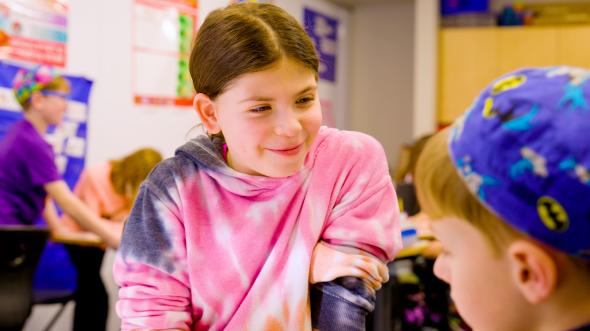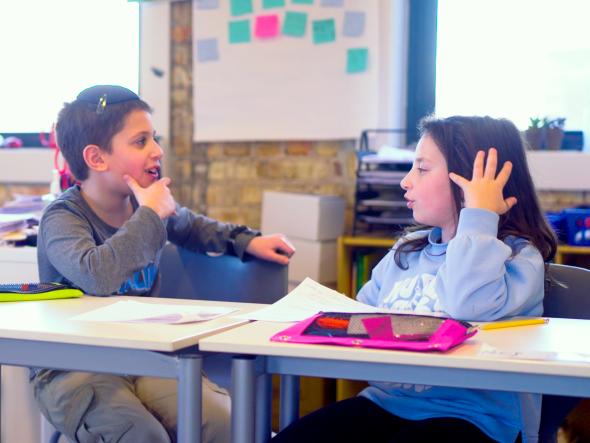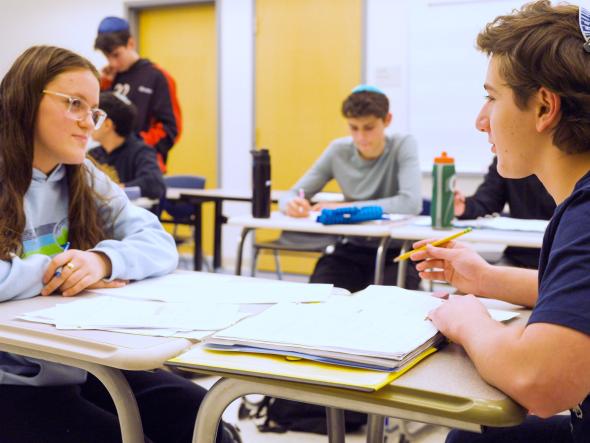Sample Class Session
The following story of a teacher and her classroom presents a composite image of many common themes emerging from actual classroom observations and teacher reflections.
In a Jewish studies classroom, students are working on a packet with text excerpts from Shemot (Exodus), translating phrases and answering questions about the text. Some students asked if they could work together, and the teacher has given permission for them to work in havruta; otherwise, students can work on their own to complete the packet.
Scanning the classroom, the teacher observes that a havruta group has their packets open to different pages, as one student is working on one set of questions while the other is working on the next, having divided up the assignment. They mostly talk and laugh together about an upcoming school sporting event, punctuated by the occasional check-in about what a Hebrew word means in the text or “what did you put down” for a specific question. The teacher occasionally visits them to get them back on track.
In another part of the room, a student working on her own is intently writing in her packet. The teacher anticipates that the student will finish before the rest of the class, declaring “I’m done,” and the teacher will need to provide that student with an extension activity. In a different corner of the room, another lone student sits slumped down in his chair, frowning. Staring out the window, with his packet untouched, he taps loudly on the desk with his pencil, causing his classmates repeatedly to yell out, “Stop tapping already!” He responds with an angry look.
The teacher is busy crisscrossing the room, following raised hands and answering questions. She slowly becomes aware that many of the questions are not about the text itself but about the packet directions and what she is “looking for.”
When the time is up, the teacher brings the class together for a discussion. She asks the class the first question in the packet about what Bnei Yisrael (the Israelites) have to do to prepare for receiving The Ten Commandments. Three out of 18 students raise their hands and comment in turn, directing their comments to the teacher. The rest of the class maintain a hushed hum of whispered chatter; they are not engaging with their classmates’ comments. Time is up. Kids stuff their packets in their backpacks and leave for the next class.
After the class, the teacher reflects. She is happy that the class was reasonably behaved and that they accomplished the lesson plan for the day; the unit on these chapters of Exodus is on track. The students who spoke in the class discussion seemed to know the material. She hopes that they are representative of the rest of the class; she will find out when they do their unit assessment. She wonders about the one boy in the corner, though, and makes a mental note to ask him for his packet to see what he has done.
Despite feeling on track, she is unsatisfied. The class lacks the energized buzz and love of Torah learning that she herself has experienced and inspired her to become a Torah teacher. Most of the students do not seem particularly moved or genuinely engaged in the rich lessons and ideas the Torah text raises. She wishes she could do something to breathe a different quality of learning and engagement into her class.
Over the years, she has learned classroom management strategies that have been effective for keeping the class orderly. She has employed strategies for motivation, such as giving students some choice to work together or alone and point systems for incentivizing classwork. Her curriculum packets follow the chapters she needs to cover. She has worked to include higher order questions about the text and to convert some of her assessments into options for creative projects. She is not sure what else she can do other than becoming more entertaining to grab the kids’ attention like some of her colleagues are able to do, but that just doesn’t feel like her—and anyway, she believes that the Torah should be interesting enough that she shouldn’t have to be a comedian. She wonders what other strategies she can learn to move her classroom toward the vision she holds.
But what would happen if, instead of reaching for the newest set of techniques, this teacher paused and viewed her class through the lens of Core Relationship Building Blocks? What potential might this afford her to strengthen the quality of learning in her class?
She would see that she can do more to connect with her students as individuals and to set them up to learn in relationship with the text and one another. Though not intentional, her current classroom is set up for students to care about completing activities according to the teacher’s expectations, rather than to care directly about the content and one another. The classroom culture supports students to “do school” rather than to build relationships.
Let’s listen in on the teacher’s reflections.
How am I connecting to learners and building relationships with them?
The teacher realizes that some students she does not know as well as others–and that these students have not had much of an opportunity to get to know her. She then makes sure to find formal and informal ways to connect with each student throughout the course of the class or the week. Instead of writing off the sports chatter of one havruta as a distraction to be tolerated, she sees it as an entry point for learning what is important to them and comes to understand that they are both serious athletes. She communicates her genuine appreciation for their commitment and finds a point of connection with them. In the future, she will draw on this connection to help them strengthen their havruta-learning relationship.
Similarly, the teacher realizes she needs to reach out to the disengaged solitary student in the corner. Rather than checking in with his packet, she checks in with him about what he is experiencing. She learns that he is anxious about an illness in his family, and that the idea of doing worksheets at a time like this seems totally pointless. His classmates’ reaction to his nervous noisy tapping only further exacerbates his growing sense of disconnection. She offers to be his havruta and inquires which classmate he would feel good about working with in the future.
By considering how she is connecting to individual students, she opens myriad strategies from which to choose: prioritizing hallway conversations, sitting in on specific havrutot, conducting full class warm-ups and reflections that invite sharing, asking content-based personalization questions, and so on. She can take the opportunity to share stories about her own interests, her own challenges in learning and how she herself has built her own relationship to Torah.
The teacher’s knowledge of her individual students’ lives and her consistent demonstration that she cares about them contributes mightily to her students becoming ever more present for learning.
How am I inviting in and helping each individual learner be present?
The teacher realizes that she typically skips this step in an effort “to get to work.” It dawns on her that not attending to this job of helping her students become present has contributed to a task-oriented classroom that does not yet draw on the personal investment and contribution of students.
She then builds in a two-minute routine to help her students get settled and center their awareness of themselves and others. She facilitates a class warm-up that specifically ties into themes of the Exodus text to give each student a chance to think for themselves and share. By so doing, she invites in the voices of each of her students and primes them to be able to engage in conversation with the text. Students begin to show interest in one another’s answers; energetic head nods indicate that students discover connections they would not have discovered anywhere else if it were not for the frame that the Torah text offers them.
Instead of hearing only from three students at the end of class, she makes it a goal to hear the voice of every student. She sets students up in havruta intentionally so that each student has the full opportunity—and expectation--to activate their voices and minds. With this core relational building block in mind, the teacher is able to find many ways to bring her students, in their particularity, “into the room.”








